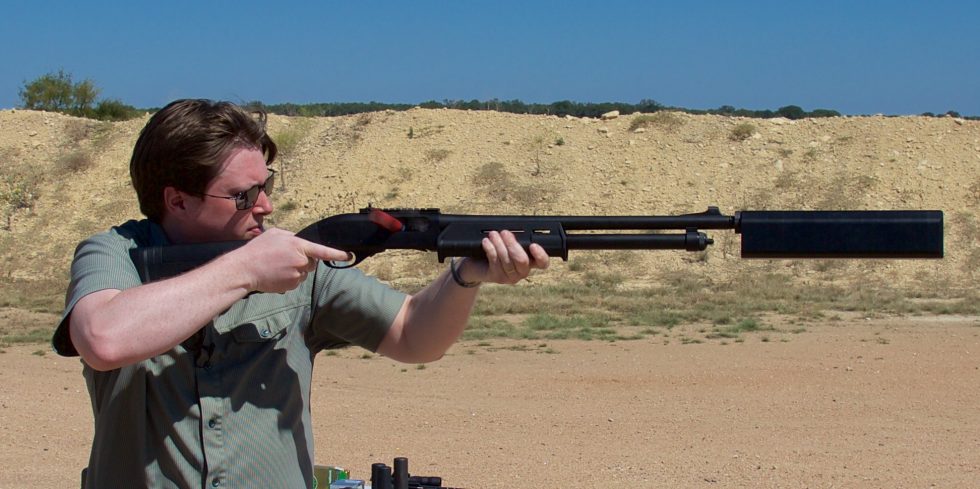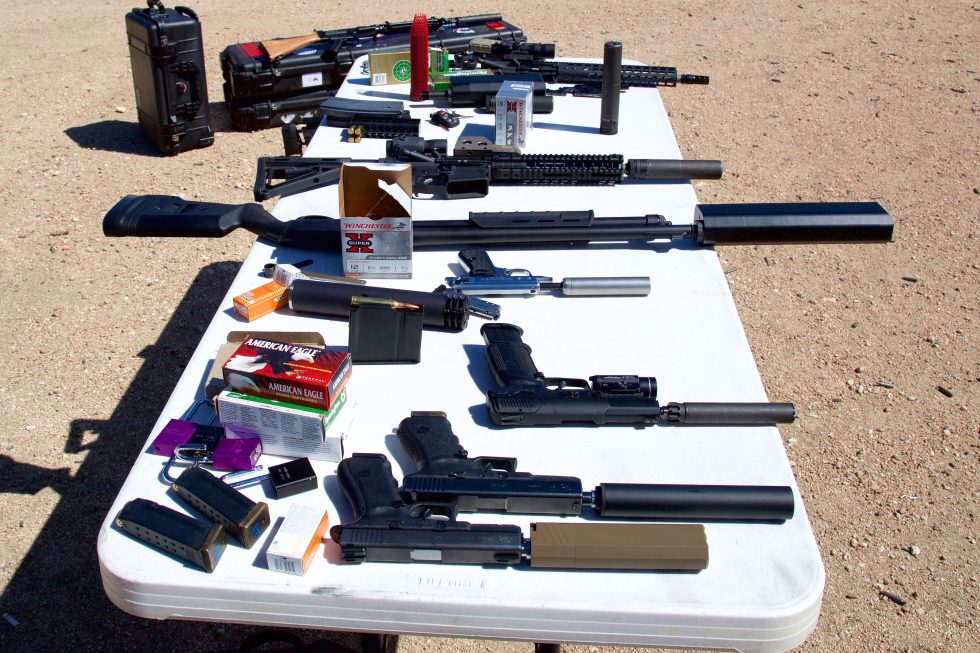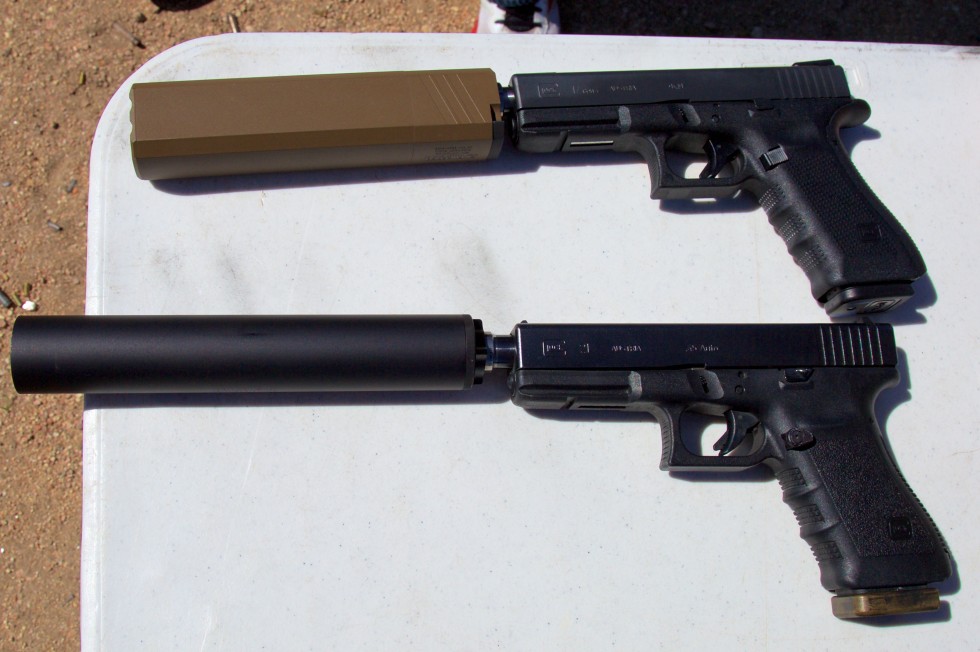
AUSTIN, Texas—Let’s get this out of the way immediately: movies and TV consistently get silencers totally wrong. The ways silencers are used on the screen—often clamped to the barrel of a submachine gun or assault rifle or large-bore pistol, mowing down bad guys while other, blissfully unaware bad guys calmly sip their tea at the end of the hallway—is just not possible. Silencers, more properly (and accurately) referred to as "suppressors," do not silence the sound of gunfire. In most cases, they don’t even make a weapon particularly quiet.
That’s first-hand information after several hours on the range with Jason Schauble of SilencerCo, where we fired off a few hundred rounds of various sizes and shapes on a wide assortment of different firearms. With the exception of small-caliber ammunition being fired out of carefully designed weapons, suppressors don’t come anywhere even close to being quiet. They’re bloody loud.
What suppressors can do is make it possible to fire a weapon, without wearing hearing protection, and retain the ability to actually hear again after. That’s another thing Hollywood gets absolutely wrong. Heroes regularly blast off hundreds of rounds in a firefight without earplugs, and they're able to hold a conversation immediately after. Anyone who’s fired a weapon before can tell you that without hearing protection, it doesn’t take more than a handful of nearby shots to temporarily deafen you—guns really are that loud.

Companies that manufacture and sell suppressors, then, have a difficult uphill battle to fight. They're working against a popular perception that these products are murder-tools best suited toward stealthily killing humans and that there are few other reasons besides "covert assassination" or possibly "taking over Nakatomi Plaza" that someone would need to own one. But after shooting for a couple of hours, we came away with the impression that suppressors are actually useful even for casual gun owners. And even if you’re not a gun person at all, the technology that goes into stealing away much of the weapon’s report noise is fascinating.
That technology is why we ended up on the range. This obviously isn’t "Guns Technica," and we don’t often seek out advancements in weaponry to cover. However, actually getting the opportunity to try out suppressors on a dozen different weapons in order to dig into how they work was too much to resist. So we went to Austin and met Schauble, who brought a veritable smorgasbord of firearms and SilencerCo-produced suppressors to walk us through how it all worked.
SilencerCo: New company, old faces
If Jason Schauble’s name sounds vaguely familiar, it’s because this isn’t the first time Ars has run into him. Schauble is the former CEO of TrackingPoint, the company that makes highly accurate (and highly expensive) Linux-powered firearms. We most recently wrote about TrackingPoint back in August when we got some hands-on time with the company’s preproduction AR-15 carbines. At that time, we mentioned that Schauble left the company a few months prior, but didn’t get into where.
It turns out that he hopped across town to SilencerCo, working in the Austin branch of the Utah-based company as its Chief Revenue Officer. His past experience at Remington and Advanced Armament Corporation (not to mention his active duty service in the Marine Corps) seems to have prepared him well for the job. When we rolled up to the Best of the West range—the same range where we shot with TrackingPoint—Schauble already had a long table laid out with firearms and suppressors.
-
Jason Schauble, SilencerCo chief revenue officer and former TrackingPoint CEO.Lee Hutchinson
-
Schauble arrived at the range early with samples of his company's wares.Lee Hutchinson
-
We fired a good mix of pistols and rifles, even one shotgun. In each case, the suppressors made ear protection unnecessary—but sometimes only just.Lee Hutchinson
-
Firearms visible here from top to bottom are a Glock 17 (9x19mm), an FN Five-seven (5.7x28mm), a Walther PPK/S (.22LR), a Glock 21 (.45 ACP), a Remington 870 12-gauge shotgun, and a Noveske AR-15 in 5.56mm NATO.Lee Hutchinson
-
SilencerCo's logo on the optic affixed to Schauble's XM2010 third-gen prototype rifle.Lee Hutchinson
SilencerCo, it turns out, is a major player in a seemingly off-the-radar industry. Though it employs only 125 people, the company has about 40 percent of the domestic suppressor market—so they’re responsible for a big chunk of the more than 100,000 suppressors purchased yearly in the United States. The company has been selling suppressors since 2009, and it’s a growing market. According to marketing materials provided by SilencerCo, suppressor sales in the United States are rising at a rate of about 20 percent a year. For 2014, SilencerCo expects to sell about 40,000 of the devices to customers ranging from private individuals to local law enforcement to military.
SilencerCo was originally started by two fellows named Josh Waldron and Jonathan Shultz—a photographer and an audio technician. The pair was frustrated with both the process of buying suppressors and also what they felt was a lack of customer service by existing suppressor manufacturers (so they decided to start their own company in an attempt to do better). One of the first products the duo designed and built was the Osprey suppressor—a non-round "eccentric" silencer that stands out in a lineup of its typically cylindrical fellow silencers. "Eccentric" here means that the bore through which the bullet passes doesn’t go through the middle of the suppressor. SilencerCo made this choice because most cylindrical suppressors actually stick up past the gun’s front sights, obscuring them and making it much more difficult to effectively aim. The Osprey design avoids this by putting most of its guts below the bore, leaving the gun’s sights usable.

reader comments
341